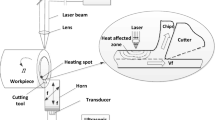Abstract
In this paper, the cutting modes for grooving a tungsten carbide work material are investigated and presented. The grooving tests were carried out on an inclined workpiece surface using a solid CBN tool on a CNC lathe. The experimental results indicated that there was a transition from a ductile mode cutting to a brittle mode cutting in the grooving of tungsten carbide workpiece material as the depth of cut was increased from zero to a critical value. Ductile mode cutting is identified by the machined workpiece surface texture and the material removal ratio f ab -ratio of the average of the volume of material removed to the volume of the machined groove. Scanning electron microscopy (SEM) observations on the machined workpiece surfaces indicated that there are three cutting modes in the grooving of tungsten carbide as the depth of cut increased: a ductile mode, a semi-brittle mode and a brittle mode. The ductile cutting mode depends on the stress in the cutting region, i.e., whether or not the shear stress in the chip formation region is greater than the critical shear stress for the chip formation (τ slip >τ c ), and whether or not the fracture toughness of the work material is larger than the stress intensity factor (K 1<K c ). When (τ slip <τ c ) and (K1>K c ), crack propagation dominates, the chip formation and the cutting mode are brittle.







Similar content being viewed by others
Abbreviations
- A 1 , A 2 :
-
A cross-section areas of the ridge
- A V :
-
A cross-section area of the groove
- A W :
-
The value of A V subtracted by A 1+A 2
- F X :
-
The horizontal force
- F Z :
-
The vertical force
- K C :
-
The fracture toughness
- K I :
-
The stress intensity factor
- f ab :
-
The work material removal ratio
- f n :
-
The normal cutting force
- f t :
-
The tangential cutting force
- α:
-
The inclined angle
- τ c :
-
The critical shear stress for dislocation
- τ slip :
-
The shear stress in chip formation zone
References
Takahashi T, Freise EJ (1965) Determination of the slip systems in single crystals of tungsten monocarbide. Philosoph Mag 12:1–8
Jia K, Fischer TE (1997) Sliding wear of conventional and nanostructured cemented carbides. Wear (203–204):310–318
Engqvist H, Ederyd S, Axen N, Hogmark S (1999) Grooving wear of single-crystal tungsten carbide. Wear 230:165–174
Johnston TL, Davies RG, Stoloff NS (1965) Slip character and the ductile to brittle transition of single-phase solids. Philosoph Mag 12:305–317
Rowcliffe DJ, Jayaram V, Hibbs MK, Sinclair R (1988) Compressive deformation and fracture in WC materials. Mater Sci Engin A105/106:299–303
Ruff AW, Shin H, Evans CJ (1995) Damage process in ceramics resulting from diamond tool indentation and scratching in various environments. Wear (181–183):551–562
Wang Y, Hsu SM (1996) Wear and wear transition mechanisms of ceramics. Wear 195:112–122
Wang Y, Hsu SM (1996) Wear and wear transition modeling of ceramics. Wear 195:34–46
Upadhyaya GS (1996) Nature and properties of refractory carbides. Nova Science Publishers, New York
Exner HE (1979) Physical and chemical nature of cemented carbide. Int Metal Rev 24:149–173
Pierson HO (1996) Handbook of refractory carbides and nitrides: properties, characteristics, processing and applications. Noyes Publications, Westwood, NJ
Liu K, Li XP (2001) Ductile cutting of tungsten carbide. J Mater Process Technol 113:348–354
Liu K, Li XP (2001) Modeling of ductile cutting of tungsten carbide. Trans NAMRI/SME 29:251–258
Zum Gahr KH (1987) Microstructure and wear of materials. Elsevier, Amsterdam
Topper TH, Yu MT (1985) The effect of overloads on threshold and crack closure. Int J Fatigue 7:159–164
Suresh S (1991) Fatigue of materials. Cambridge University Press, New York
Acknowledgements
The authors would like to express their sincere thanks to Mori Seiki, Japan, for the company’s generous donation of the CNC lathe, the SL-35, to our advanced manufacturing laboratory, on which the grooving experimental tests of this study were carried out.
Author information
Authors and Affiliations
Corresponding author
Rights and permissions
About this article
Cite this article
Liu, K., Li, X.P., Rahman, M. et al. A study of the cutting modes in the grooving of tungsten carbide. Int J Adv Manuf Technol 24, 321–326 (2004). https://doi.org/10.1007/s00170-003-1565-6
Received:
Accepted:
Published:
Issue Date:
DOI: https://doi.org/10.1007/s00170-003-1565-6



